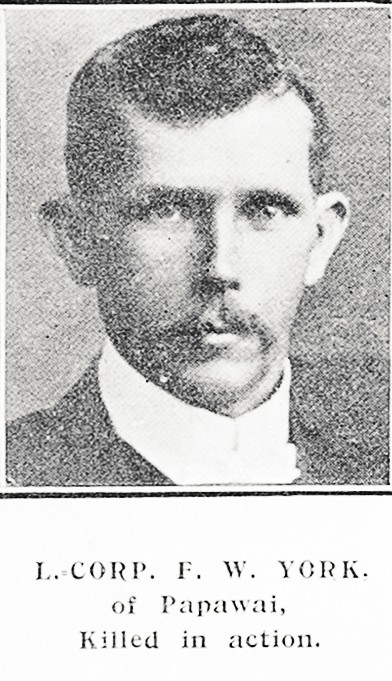Rfn
Frank Warren York
Informatie over geboorte
|
Geboortedatum: 03/10/1871 |
|
Geboorteplaats: Nelson, Nelson Bay, Nieuw-Zeeland |
Algemene Informatie
|
Beroep: Aannemer |
Informatie legerdienst
|
Land: Nieuw-Zeeland |
|
Strijdmacht: New Zealand Expeditionary Force |
|
Rang: Rifleman |
|
Service nummer: 48133 |
|
Dienstneming datum: 25/01/1917 |
|
Dienstneming plaats: Greytown, Wellington, Nieuw-Zeeland |
|
Eenheden: — New Zealand Rifle Brigade, 3rd Bn. (Laatst gekende eenheid) |
Informatie over overlijden
|
Datum van overlijden: 20/11/1917 |
|
Plaats van overlijden: Polygoonbos, Zonnebeke, België |
|
Doodsoorzaak: Killed in action (K.I.A.) |
|
Leeftijd: 46 |
Begraafplaats
|
Buttes New British Cemetery, Polygon Wood Plot: IX special Memorial Rij: AA Graf: 5 |
Onderscheidingen en medailles 2
|
British War Medal Medaille |
|
Victory Medal Medaille |
Points of interest 3
| #1 | Geboorteplaats | ||
| #2 | Dienstneming plaats | ||
| #3 | Plaats van overlijden (bij benadering) |
Mijn verhaal
Frank York was born in Nelson, New Zealand, on 2 October 1871. He was one of 10 children of George and Sarah York and his family moved to Greytown in the Wairarapa district, North Island in the 1880s.
He married Evelyn Elizabeth Wilson in 1908. The couple had a daughter, Evelyn Winifred in 1910. The marriage was brief, with Frank’s wife dying in 1912. Frank lived at Papawai, near Greytown, and worked as a contractor.
Frank Warren was 45 years of age when he enlisted at Greytown on 25 January 1917. He was called into camp on 5 March as part of the 26th Reinforcement, in a NZ Rifle Brigade training company. He was promoted to lance corporal on 19 April 1917 during training at Trentham and Featherston camps, before embarking on the troop ship Maunganui on 12 June, arriving in Devonport, England on 16 August 1917.
He reverted to the ranks and did further training at Brocton Camp before sailing to France on 18 October 1917. He was briefly in Etaples before being posted to C Company, 3rd Battalion New Zealand Rifle Brigade on 25 October.
The New Zealand Division was in the Polygon Wood area, after the end of the Third Battle of Ypres. Much of the time was spent in wiring, repairing crumbling trenches and improving defences. The landscape was covered with waterlogged shellholes. The opposing German forces generally held higher ground and movement in the New Zealand lines was often observed and shelled or machine-gunned.
The Division relieved the 21st Division from 13th November, when the 3rd (NZ Rifle Brigade) and 4th NZ Infantry Brigades took over the front line. On the 15th the 3rd Battalion moved into support behind the 1st and 4th Battalions of the Rifle Brigade. On the night of 19/20 November his battalion moved into the front line, with machine guns, artillery and snipers all active. It is difficult to say how Frank York died on 20 November 1917 but artillery fire is the most likely cause.
Subsequent fire disrupted burials in this area near the Butte of Polygon. He is now in a special memorial area of Buttes New British Cemetery, ‘Men buried in this cemetery’, in Plot IX, Row AA, Grave 5.
He married Evelyn Elizabeth Wilson in 1908. The couple had a daughter, Evelyn Winifred in 1910. The marriage was brief, with Frank’s wife dying in 1912. Frank lived at Papawai, near Greytown, and worked as a contractor.
Frank Warren was 45 years of age when he enlisted at Greytown on 25 January 1917. He was called into camp on 5 March as part of the 26th Reinforcement, in a NZ Rifle Brigade training company. He was promoted to lance corporal on 19 April 1917 during training at Trentham and Featherston camps, before embarking on the troop ship Maunganui on 12 June, arriving in Devonport, England on 16 August 1917.
He reverted to the ranks and did further training at Brocton Camp before sailing to France on 18 October 1917. He was briefly in Etaples before being posted to C Company, 3rd Battalion New Zealand Rifle Brigade on 25 October.
The New Zealand Division was in the Polygon Wood area, after the end of the Third Battle of Ypres. Much of the time was spent in wiring, repairing crumbling trenches and improving defences. The landscape was covered with waterlogged shellholes. The opposing German forces generally held higher ground and movement in the New Zealand lines was often observed and shelled or machine-gunned.
The Division relieved the 21st Division from 13th November, when the 3rd (NZ Rifle Brigade) and 4th NZ Infantry Brigades took over the front line. On the 15th the 3rd Battalion moved into support behind the 1st and 4th Battalions of the Rifle Brigade. On the night of 19/20 November his battalion moved into the front line, with machine guns, artillery and snipers all active. It is difficult to say how Frank York died on 20 November 1917 but artillery fire is the most likely cause.
Subsequent fire disrupted burials in this area near the Butte of Polygon. He is now in a special memorial area of Buttes New British Cemetery, ‘Men buried in this cemetery’, in Plot IX, Row AA, Grave 5.
Bronnen 7
|
"The Official History of the New Zealand Rifle Brigade (The Earl of Liverpool's Own)", Austin W.S., The Naval & Military Press Ltd., 2007, page 251 - 254 Gebruikte bronnen |
|
Auckland Cenotaph https://www.aucklandmuseum.com/war-memorial/online-cenotaph/record/C13864?n=York%2048133&ordinal=0&from=%2Fwar-memorial%2Fonline-cenotaph%2Fsearch Gebruikte bronnen |
|
CWGC https://www.cwgc.org/find-war-dead/casualty/480514/york,-frank-warren/ Gebruikte bronnen |
|
Image http://media.api.aucklandmuseum.com/id/media/v/301983?rendering=original.jpg Gebruikte bronnen |
|
NZEF Project https://nzef.adfa.edu.au/showPerson?pid=283483 Gebruikte bronnen |
|
Service Records http://ndhadeliver.natlib.govt.nz/delivery/DeliveryManagerServlet?dps_pid=IE21257803 Gebruikte bronnen |
|
The Long, Long Trail https://www.longlongtrail.co.uk/army/ Gebruikte bronnen |
